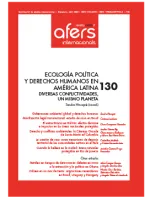“Transfer of use rights” as a mechanism for the territorial dispossession of native communities in Peru

Juan Carlos Ruiz Molleda. Abogado, Pontificia Universidad Católica del Perú; coordinador del área de Litigio Constitucional, Instituto de Defensa Legal (Perú). jruiz@idl.org.pe. ORCID: https://orcid.org/0000-0003-1316-0313
Olga Cristina del Rocío Gavancho León. Abogada, especialista en Justicia Constitucional, Interpretación y Aplicación de la Constitución; consultora del Instituto de Defensa Legal, región San Martín (Perú). cris_gavancho@hotmail.com. ORCID: https://orcid.org/0000-0001-5696-9986
This paper analyses the Peruvian institutional scaffolding that favours mechanisms for dispossessing land from indigenous peoples in Peru, despite their protection by regulations that recognise them as such and their constitutional status, which imposes binding obligations. International human rights protection standards are therefore violated, along with the International Labour Organization’s Convention 169 and the jurisprudence of the Inter-American Court of Human Rights (IACHR). It is therefore noteworthy that the Peruvian State has approved the titling of indigenous peoples’ lands that are suitable for forestry “transfer of use rights” – the main mechanism of dispossession affecting the ancestral territories of the indigenous peoples of the Peruvian jungle.
Keywords: Peru, ILO Convention 169, human rights, indigenous peoples, “transfer of use rights”, land titling
How to cite this article: Ruiz Molleda, Juan Carlos y del Rocío Gavancho León, Olga Cristina. «La “cesión de uso” como mecanismo de despojo territorial de las comunidades nativas en el Perú». Revista CIDOB d’Afers Internacionals, n.º 130 (abril de 2022), p. 119-138. DOI: doi.org/10.24241/rcai.2022.130.1.119
Revista CIDOB d’Afers Internacionals, n.º 130, p. 119-138
Quadrimestral (January-April 2022)
ISSN:1133-6595 | E-ISSN:2013-035X
DOI: https://doi.org/10.24241/rcai.2022.130.1.119
Reception date: 22.09.21 ; Acceptance date: 17.01.22
>> The full text articles are available in Spanish language, although in this issue some of them are also available in English language.